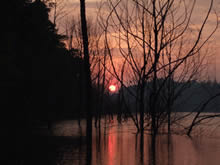
Sebarau by night
by Christopher S. G. Tan
Insomnia is a condition I suffer from the night before a fishing trip. Initially I thought that this problem of getting a solid night's sleep would lessen the more fishing I did, but I guess the excitement of going fishing has not dwindled over the years.
I had often wondered if I was the only one afflicted with this malady, as some of my fishing partners have contributed to my lack of sleep with their loud rumbling snores while in an unfair deep and restful sleep. Of recent years I have discovered that I am not alone and there are other keen anglers with the same affliction. Where am I going with this bizarre rambling?
Well, there is not much known about our local fish, as published studies about them are "scarcer than hen's teeth". We are generally left with angler lore and hearsay about our local species; that that which is factual can be as precious as a jewel. Still wondering what I am babbling about?
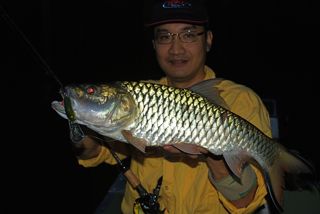 Well the question that relates to my pre-fishing sleeping habits is: What do Malaysian fish do at night? Do they sleep or feed? We all know that members of the catfish family are commonly caught during the nocturnal hours, but what about fish like the sebarau which are normally targeted during waking hours? Can they be fished for at night? Should we put in the hours after sunset, neglecting the Zzzzzs?
Well the question that relates to my pre-fishing sleeping habits is: What do Malaysian fish do at night? Do they sleep or feed? We all know that members of the catfish family are commonly caught during the nocturnal hours, but what about fish like the sebarau which are normally targeted during waking hours? Can they be fished for at night? Should we put in the hours after sunset, neglecting the Zzzzzs?
Early one morning, I was compelled into going fishing due to "insomnia". We had breakfast at 5am and pushed off an hour before dawn. Our destination was a nearby spot that was easily identified by the lights. Considering that in the saltwater environment, lights from ramps and jetties make great fish attractions, it might be the same in the freshwater situation. Motoring a boat in the dark is always dangerous, but our lighted destination ahead of us allowed us to spot any floating logs and other hazardous objects between us and our destination.
The lighted area made it easy for us to cast without messing up our baitcasters as we could see the flight of our lures. I had decided to stick with small Skitter Pops, whereas my compatriot chose to use shallow runners like Shad Raps. I was pretty surprised to be hit on the first cast. It gave a short struggle and shook off the little popper. Following that I had another two hits, but no hook ups, which is not surprising as the hook up rate for poppers is always poorer than subsurface lures. Although we did not see any of the fish that went for the poppers, we were pretty convinced that they were sebarau as during the daylight hours, that spot was a prime sebarau spot; it was possible that sebarau did feed at night. As the distant horizon grew light, the bites stopped and we headed off to some other fishing holes for some regular style sebarau fishing.
Sebarau (Hampala Barb) fishing in the night-time is not done by many lure fishermen, principally due to the fact that it is dark! And when it is dark we cannot see. Since sebarau fishing is normally done with lures and due to the habitat of sebarau being normally structure orientated, being able to see precisely to place the lure next to that branch or point requires some light to see by.
Another factor is that fishing for sebarau these days requires one to boat or trek into less pressured waters. Thus getting out of such locations after dark or to the locations before sunrise has dangers and difficulties.
Once we knew of a spot we wanted to fish till dark. My past experience here had shown that often the sebarau would only bite when it got almost dark, with barely enough light to cast with, thus requiring us to move back to our campsite in the dark by the time we finished fishing. We knew the waterway well enough not to hit any objects and there were not any floating logs enroute that day. To find our campsite in the dark, we had identified some prominent landmarks that could be picked out by torch-light as our camp was well hidden behind trees and would be difficult to find. Even then it was not easy to find our campsite and to make things easier, we left a lamp on the following evening, which made it considerably easier to spot our campsite.
Working the area also requires preparation. Nothing elaborate, just some common-sense awareness of the surroundings while it is still light. Recently on the spur of the moment, we decided to fish into the night at a spot that had been productive for us in the day time. We stayed in the area from sunset till dark, familiarising ourselves with the surrounding areas and landmarks so that we would know where to place the boat and the lures.
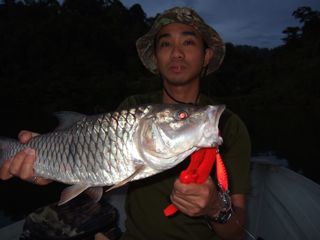 Though it was a dark and moonless night, we still could make out the outlines of the hills and the reflections off the water, which gave us some references to work with, limited but still useful and helpful. Even though we messed up at times, getting the boat too close to the bankside or snagging our Tilsan bass lures on things other than fish, we still considered it a successful night, bagging several sebarau each in just over an hour of very dark fishing.
Though it was a dark and moonless night, we still could make out the outlines of the hills and the reflections off the water, which gave us some references to work with, limited but still useful and helpful. Even though we messed up at times, getting the boat too close to the bankside or snagging our Tilsan bass lures on things other than fish, we still considered it a successful night, bagging several sebarau each in just over an hour of very dark fishing.
Land based fishing is much the same, normally picking out a spot while it is still light and figuring out the distances and directions to cast to. While it is getting dark, keep note on the visible outlines of the key landmarks to keep directional awareness of the casting bearings updated.
Any form of nocturnal travel is fraught with dangers, so always proceed with caution and carry two torches. It is an obvious fact but I will point out that in waters with obstructions, do not tear along at high speed but motor along slowly and be patient! I use a moderate sized torch for navigation and use a headlamp for landing the fish and also unhooking and releasing the sebarau. The headlamp is also useful for other close in work as it keeps the hands free. Two torches also provides a backup in case one fails.
So there are times when sebarau will feed in the dark, which makes it worthwhile to lose some sleep. I have yet to find out personally if they feed at midnight, but maybe one night I might, especially if the campsite is filled with loud and sleep disturbing rumbles!
Conservation
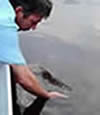
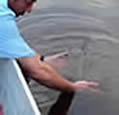
We need to protect and conserve our resources by practising catch and release of our sportfish and protecting the habitat of our fishes.
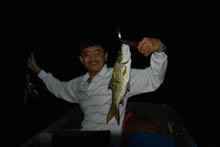
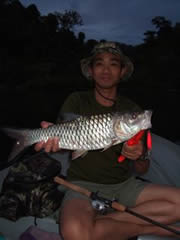
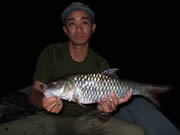

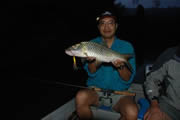
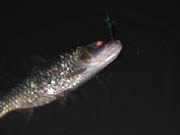 Small sebarau caught with a small Halco Scorpion.
Small sebarau caught with a small Halco Scorpion.